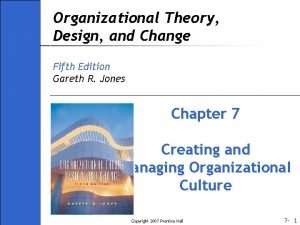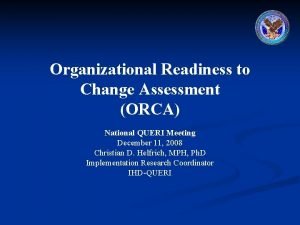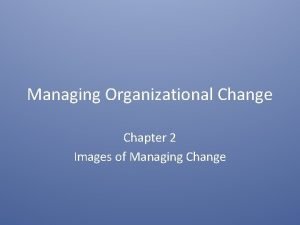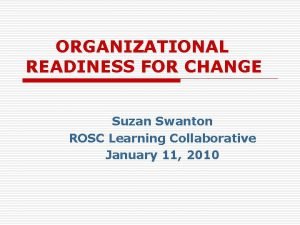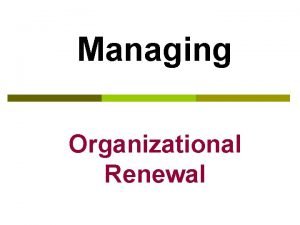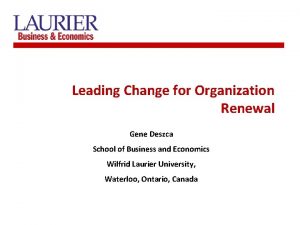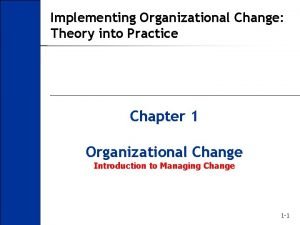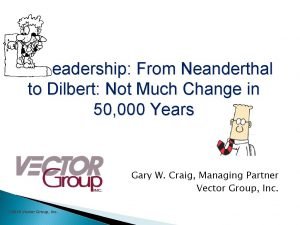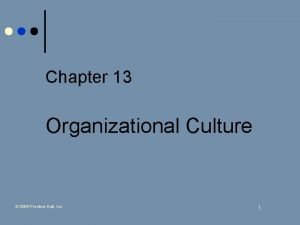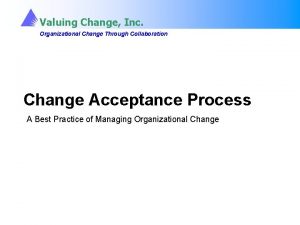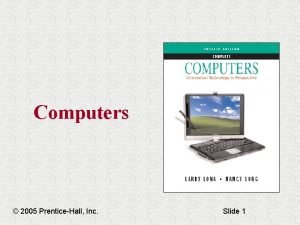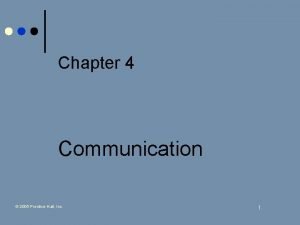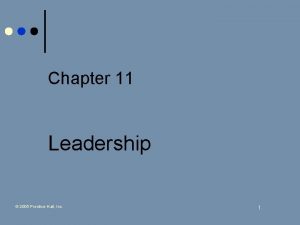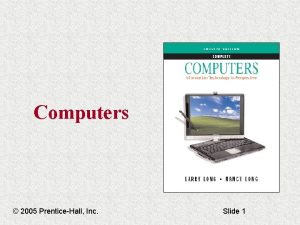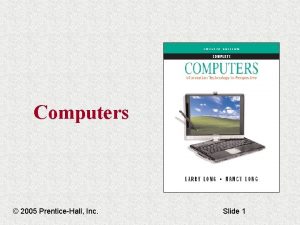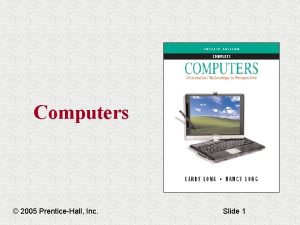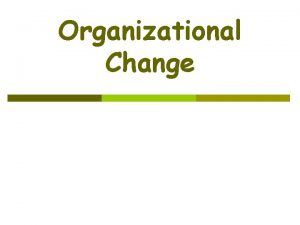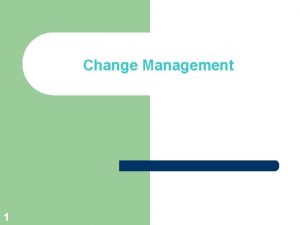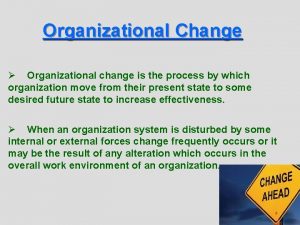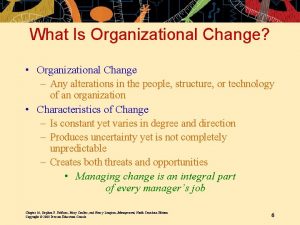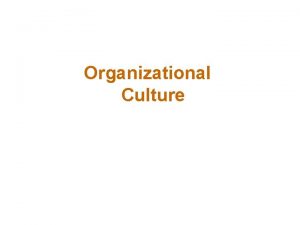Chapter 14 Organizational Change 2005 PrenticeHall Inc 1
























- Slides: 24

Chapter 14 Organizational Change © 2005 Prentice-Hall, Inc. 1

Learning Objectives Define organizational change and understand why managing organizational change is an important part of international management ¢ Understand the individual, group, and structural levels of change ¢ Know what internal and external factors influence organizational change ¢ Explain the role of national and organizational culture on organizational stability and change ¢ © 2005 Prentice-Hall, Inc. 2

Learning Objectives Understand the processes involved in planned organizational change, including sources of resistance to change and ways to overcome them ¢ Understand how macro level theories of organizational change influence the management of change ¢ © 2005 Prentice-Hall, Inc. 3

Organizational Change Reconfigures components of an organization to increase efficiency and effectiveness © 2005 Prentice-Hall, Inc. 4

Levels of Organizational Change ¢ Individual Change l ¢ Behavior of a person is different as a result of new information, training, experience, or rearrangement of an organization's structure Group Change l Can take several forms including new leadership, increased or diminished cohesiveness, transition into a team © 2005 Prentice-Hall, Inc. 5

Levels of Organizational Change ¢ Structural Change l Deliberate rearrangement of positions, departments, or other major units of organization © 2005 Prentice-Hall, Inc. 6

Internal Change Factors ¢ Technical production processes Production l New technologies l Quality l ¢ Political processes New organizational goals l Conflict l New leadership l © 2005 Prentice-Hall, Inc. 7

Internal Change Factors ¢ Organizational culture l Values l Norms l New member socialization © 2005 Prentice-Hall, Inc. 8

External Change Factors ¢ The immediate environment © 2005 Prentice-Hall, Inc. l Domestic competition l Population trends l Social trends l Government actions 9

External Change Factors ¢ The general environment Foreign competition l Social movements l Political-economic movements l Technology l Professionalization l Culture contact l © 2005 Prentice-Hall, Inc. 10

Change Variables and Culture Relationship between values and behavior may vary with culture so in some cultures individuals can change behavior without changing their values ¢ Internal and external variables exist in context of national and organizational culture; simultaneously influence culture and are influenced by it ¢ © 2005 Prentice-Hall, Inc. 11

National Culture and Organizational Change Time orientation ¢ Resistance to change ¢ Tradition l Habit l Resource limitations l Power and influence l Fear of the unknown l Values l © 2005 Prentice-Hall, Inc. 12

Resistance to Change in Different Clusters of Countries Dimension Scores Resistance level PD ID UA 4 (strongest) high low high Most of Latin America, Portugal, Korea, the former Yugoslavia 3 (strong) med high high Japan Belgium, France Spain, Argentina, Brazil, Greece, Turkey, Arab Countries high low med Indonesia, Thailand, Taiwan, Iran, Pakistan, African countries © 2005 Prentice-Hall, Inc. Country Clusters 13

Resistance to Change in Different Clusters of Countries Dimension Scores Resistance level PD ID UA Country Clusters 2 (medium) high low med high low high med Philippines, Malaysia, India Austria, Israel Italy, Germany, Switzerland, South Africa 1 (week) med high low Singapore, Hong Kong, Jamaica 0 (weakest) low high low Anglo countries, Nordic countries, Netherlands © 2005 Prentice-Hall, Inc. 14

Organizational Culture and Change ¢ ¢ Managing change l Top-down vs. bottom-up l Which components to change and how Organization development l Tries to improve organizational efficiency and effectiveness, create organizational "health, " build capacity for continuous change © 2005 Prentice-Hall, Inc. 15

Lewin’s Model of Change © 2005 Prentice-Hall, Inc. ¢ Phase 1 - Diagnosis ¢ Phase 2 - Unfreezing ¢ Phase 3 - Movement ¢ Phase 4 - Refreezing ¢ Phase 5 - Renewal 16

Managing Resistance to Change ¢ Education and communication ¢ Participation and involvement ¢ Negotiation and agreement ¢ Manipulation and co-optation ¢ Coercion © 2005 Prentice-Hall, Inc. 17

The Interaction of National and Organizational Cultures ¢ Determining extent to which national values resist change and fit a change strategy to them ¢ More technologically- and knowledge-oriented organizational cultures less likely to resist change © 2005 Prentice-Hall, Inc. 18

Change Strategies for Different Groups of Countries Change Strategy Dimension Scores PD ID MA UA 5 (power) high low high Columbia, Ecuador, Venezuela, Mexico 4 (power, manipulation/ persuasion) high low med high Rest of Latin America, Spain, Portugal, former Yugoslavia, Greece, Turkey, Arab countries, Korea © 2005 Prentice-Hall, Inc. Country Clusters 19

Change Strategies for Different Groups of Countries Change Strategy Dimension Scores PD ID MA UA med high low high med low med high Japan high Belgium, France low Indonesia, Thailand, Taiwan, Iran, Pakistan, African countries low Philippines, Malaysia, India low Singapore, Hong Kong, Jamaica 2 (manipulation/ persuasion, consultation) low med high Austria, Israel med Italy, Germany, Switzerland, South Africa 1 (consultation, participation) low high low low 3 (manipulation/ persuasion) © 2005 Prentice-Hall, Inc. Country Clusters Anglo countries Nordic countries, Netherlands 20

Macro-Organizational Change Theories ¢ Life-cycle theory l ¢ Implies organizations have developmental patterns that managers have to recognize and adapt to Teleological theory l © 2005 Prentice-Hall, Inc. Relies on philosophical doctrine that purpose or goal is final cause for guiding movement of organization 21

Macro-Organizational Change Theories ¢ Dialectical theory l ¢ Evolutionary theory l ¢ Change product of conflict Views change as proceeding through a continuous cycle of variation, selection, and retention Cultural implications l © 2005 Prentice-Hall, Inc. Theories useful for analyzing organizational change in societies with different cultural orientations 22

Convergence or Divergence? ¢ ¢ Competitive pressures Attempts to standardize product quality on a worldwide basis Diffusion of advanced management techniques Transfer of technological innovations © 2005 Prentice-Hall, Inc. ¢ ¢ Problems with diffusion of organizational innovations Culture and local conditions act as barriers to change 23

Implications for Managers ¢ Culture influences organizational change ¢ When formulating a change program, assess need for change, what change appropriate, nature of resistance to change, success of planned change ¢ Be aware of internal and external forces for change and how different cultures respond to them ¢ Understand larger processes affecting organizational change and how they limit change © 2005 Prentice-Hall, Inc. 24
 2005 pearson prentice hall inc
2005 pearson prentice hall inc 2005 pearson prentice hall inc
2005 pearson prentice hall inc Chapter 18 organizational change and stress management
Chapter 18 organizational change and stress management Sys.sp_cdc_change_job
Sys.sp_cdc_change_job Organizational change adalah
Organizational change adalah Organizational change adalah
Organizational change adalah Organizational theory design and change
Organizational theory design and change Orca organizational readiness change assessment
Orca organizational readiness change assessment Organizational change in education
Organizational change in education Six images of managing change in organisation
Six images of managing change in organisation Implementing organizational change spector
Implementing organizational change spector Evaluating organizational change
Evaluating organizational change Organizational readiness for change maryland
Organizational readiness for change maryland Leading change and organizational renewal
Leading change and organizational renewal Leading change and organizational renewal
Leading change and organizational renewal Implementing organizational change theory into practice
Implementing organizational change theory into practice Dilbert organizational change
Dilbert organizational change What is an organization
What is an organization Examples for physical change
Examples for physical change Physical and chemical changes
Physical and chemical changes Absolute change and relative change formula
Absolute change and relative change formula What is integers
What is integers Difference between physical and chemical change
Difference between physical and chemical change Difference between supply and quantity supplied
Difference between supply and quantity supplied Change in supply and change in quantity supplied
Change in supply and change in quantity supplied






